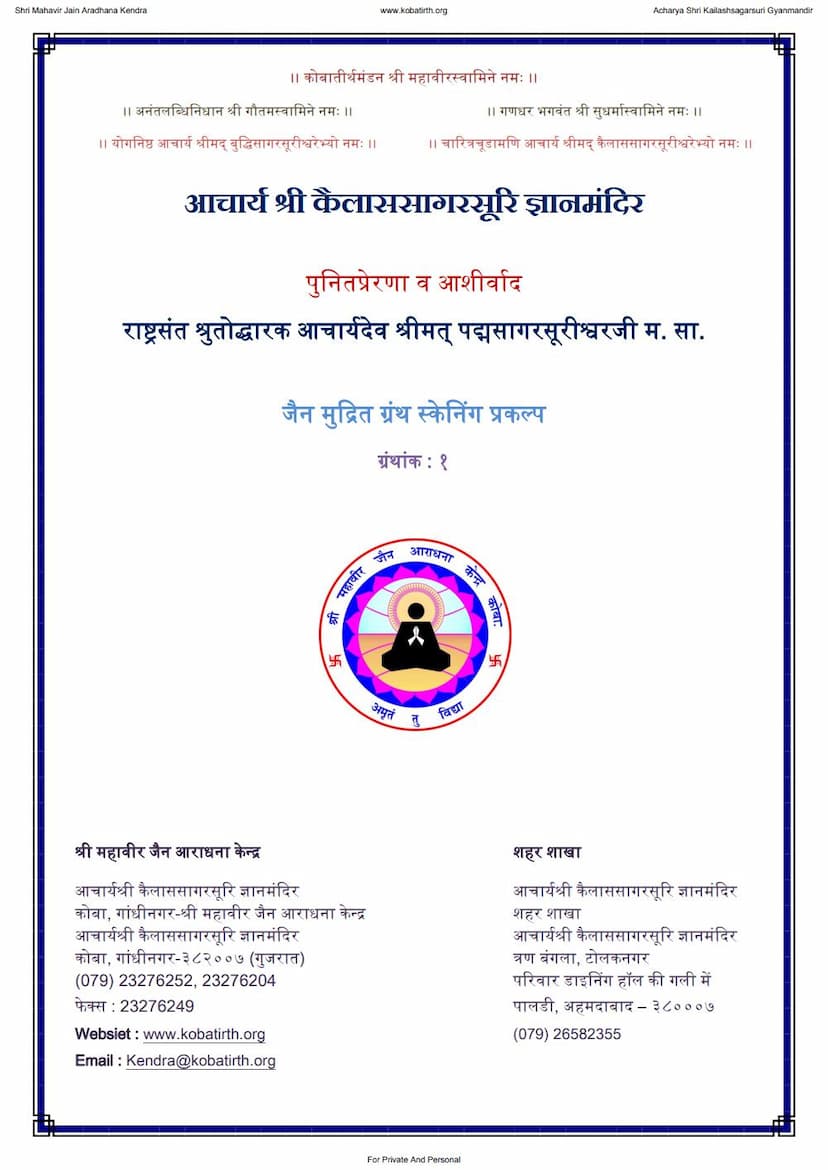Nyaya Darshan
Added to library: September 2, 2025

Summary
The provided text is a scanned version of the book "The Nyáya Darshana" by Gotama, with the commentary of Vatsyayana and the gloss of Vishwanatha, edited by Pandit Jibananda Vidyasagara B.A. and printed in 1874. The text contains the following:
-
Title Page: Clearly indicates the book title, author (Gotama), commentator (Vatsyayana), glossator (Vishwanatha), editor (Pandit Jibananda Vidyasagara), publisher (Sucharu Press), and year of publication (1874).
-
Shri Mahavir Jain Aradhana Kendra: Several pages show the affiliation with the Shri Mahavir Jain Aradhana Kendra and its website, kobatirth.org. This suggests the scanning and archiving project was undertaken by this Jain institution.
-
Table of Contents (Sūcīpatram): The bulk of the scanned pages comprise a detailed table of contents for the Nyáya Darshana. This table of contents is extensive, breaking down the text into chapters (adhyāya) and sections (āhnika), and then listing the various topics covered within each. The topics are philosophical and logical in nature, covering:
- Pramāṇa (Means of Knowledge): The text elaborates on the different pramāṇas like Pratyaksha (Perception), Anumāna (Inference), Upamāna (Analogy), and Śabda (Testimony).
- Prameya (Objects of Knowledge): It discusses the nature of the soul (Ātman), body, senses, mind, intellect, and other ontological categories.
- Doubt (Saṃśaya), Purpose (Prayojana), Example (Dṛṣṭānta), Conclusion (Siddhānta), Argumentation (Avayava), Reasoning (Tarka), Decision (Nirṇaya), Debate (Vāda), Argumentation (Jalpa), Refutation (Vitaṇḍā), Fallacious Reasoning (Hetvābhāsa), Trickery (Chala), Sophistry (Jāti), and Points of Defeat (Nigrahasthāna). These are the key elements of the Nyáya system, dealing with logic, epistemology, and the art of debate.
- The structure of the table of contents indicates a systematic breakdown of the Nyáya Sūtras and Vatsyayana's commentary. It includes topics like the nature of knowledge, the causes of error, the relationship between soul and body, the validity of testimony, and various logical fallacies.
-
Opening Verses and Salutations: The initial pages contain traditional salutations and respectful invocations to Jain spiritual figures like Shri Mahavir, Shri Gautam Swami, Acharya Buddhisagarsuri, and Shri Sudharmaswami, as well as general auspicious phrases.
-
Commentary Sections: Several pages display the beginning of the commentary, starting with the invocation "Om Namah Pramānāya" and an introductory explanation of the purpose of knowledge and its relation to action. The text delves into the definition of proof (pramāṇa) and its importance for understanding reality. It outlines the sixteen categories of Nyáya philosophy. The commentary then proceeds to analyze the sūtras, defining terms, explaining concepts, and refuting opposing views.
-
Specific Nyáya Concepts: The table of contents and commentary excerpts cover fundamental Nyáya concepts such as:
- The four means of valid knowledge: Perception (pratyakṣa), Inference (anumāna), Comparison (upamāna), and Testimony (śabda).
- The sixteen categories (padārtha) of Nyáya.
- The structure of a valid argument (avayava), including the proposition (pratijñā), reason (hetu), example (udāharaṇa), inference (upanaya), and conclusion (nigamana).
- The analysis of fallacious reasoning (hetvābhāsa) and their classification.
- The process of debate and the fallacies used in it (jalpa, vitaṇḍā, chala, jāti, nigrahasthāna).
- The ultimate goal of Nyáya, which is liberation (apavarga) through right knowledge (tattva-jñāna).
In essence, the document represents a foundational text of Indian philosophy, specifically the Nyáya school, which is concerned with logic, epistemology, and metaphysics. The scanning project by the Jain Aradhana Kendra highlights the preservation and accessibility of significant philosophical works, even if the text itself originates from a non-Jain tradition. The extensive table of contents is crucial for understanding the scope and detailed structure of the philosophical discourse presented in the book.